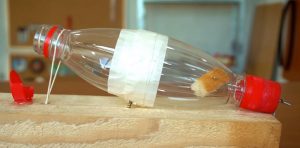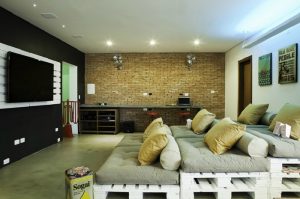Last Updated on October 30, 2025 by teamobn
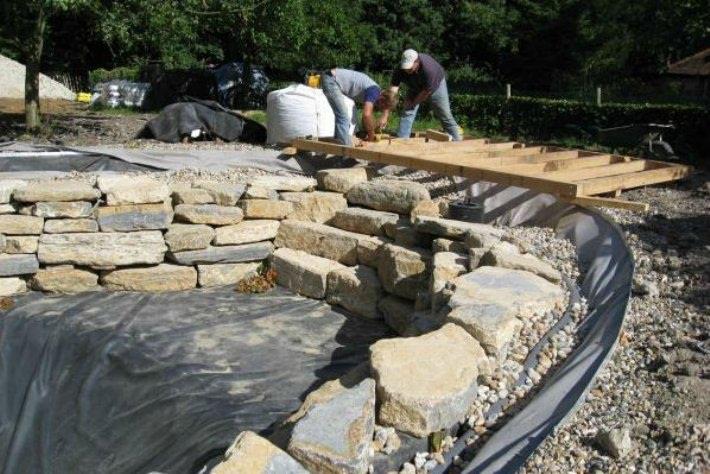
We got great feedback when we introduced you to the ultimate swimming pond. If you missed the post, you can read it here.
We live in a climate where being able to ‘take a dip’ is almost obligatory. But, if you’ve had a pool previously, you know that it’s not all fun! Pools are expensive to install and maintain. And they demand your time or an investment in a ‘pool guy’.
When we saw the swimming pond concept, it was love at first sight. Your comments told us we were not alone. Don’t be bashful… let’s do something about it! How about having your own pond in time for the next swimming season?
As you consider building your natural swimming pond, connecting with skilled swimming pond builders can be a game changer. Experts can offer essential guidance and support, ensuring your project not only meets but exceeds your expectations.
Engaging with professionals from the start can significantly simplify the construction process, offering insights into the best materials and sustainable techniques that blend seamlessly with your landscape. These specialists have a deep understanding of ecological balance, ensuring that your pond is not only beautiful but also beneficial to local flora and fauna.
Professional pond builders will conduct a thorough assessment of your property to suggest the optimal location and size for your swimming pond. This evaluation includes considering sun exposure, drainage, and proximity to natural resources, which are crucial for maintaining the health and clarity of the pond. By leveraging their expertise, you can avoid common pitfalls that might compromise the structure of your pond and/or quality of the water.
Moreover, experienced builders can navigate local regulations, which is essential for obtaining necessary permits and ensuring compliance. They are also equipped to implement innovative features such as natural filtration systems, which use plants and natural substrates instead of chemicals to purify the water. This not only enhances the aesthetic appeal of the pond but also creates a healthier swimming environment.
Collaborating with expert builders also means access to customised designs that reflect your personal style and fit perfectly within your outdoor space. Whether you prefer a minimalist modern look or a more rustic, naturalistic setting, they can tailor the design to match your vision.
Contents
Key Takeaways
- Soil testing, groundwater mapping, and a protected liner prevent leaks, bank failure, and costly rework.
- Correct pump sizing with low-head plumbing delivers clear water, quiet circulation, and lower energy bills.
- Early planning for permits, safety, and maintenance keeps a natural swimming pond swimmable and compliant year-round.
DIY Ultimate
This is truly a DIY project. You can have your pond and your bank account too! It’s in harmony with nature, will enhance your lifestyle and turn your yard into the Garden of Eden. And the best part is that it is very low maintenance.
It’s the perfect solution for those of us who have had pools and the headaches inherent with them.
Have you got doubts? Do you think the project might be beyond your skills? Maybe you think you don’t have enough space. Read on while we show you just how easy this is…
Council approval
The councils we surveyed didn’t have a clue what we were talking about 🙂 Obviously, a swimming pond just doesn’t fit into their neat little boxes. If it is a pond and is NOT used for swimming or ‘paddling’, it appears that neither approval nor a pool fence is needed.
If the intention IS to use the pond for swimming or even for ‘paddling’, a fence is needed if depth exceeds – wait for it… 300mm! A pool fence requirement draws in the need for council approval.
It appears to be a moot point. A dam does not require fencing even though it may be used for swimming. You’ll have to do your own homework. However, be aware that if you do need approval, the penalties for not complying can be harsh – especially in regard to fences.
The right location
Sometimes it pays to state the obvious…
Where are your drains and services? Make sure you know where everything is before you start digging. Of course, some services like stormwater are easily redirected. In fact, that same roof water can be redirected to your new pond rather than flowing uselessly to the street!
Other services like underground power or sewerage lines are a much bigger challenge. Apart from direct cost, they may also involve your local government.
You also need to consider nearby trees. A fig or a willow will love your pond more than you will! If you want a beautiful, verdant look without future problems, consider plants like cordylines, tiger grass (Thysanolaena maxima), crotons and even some of the smaller clumping bamboos like Rachal Carson or Gracilis.
The right aspect
If you live on a larger block, you may have a choice of aspect. It’s tempting to put your pond out in the open where it can get as much sun as possible. Think twice! A little bit of shade can actually extend the usability of your pond.
The right size
Big may be beautiful but not if it restricts or denies use of your yard for other recreational pursuits. Will you use your pond to swim or just to cool off? Even for swimming, you might want to consider long and narrow rather than long and wide. Remember, you have to keep water up to your pond just as you would a pool.
You also need to consider the regeneration zone. If you want a near zero maintenance pond, the regeneration zone needs to be of equal size to the swimming zone. This also avoids the need for any additional sterilization such as artificial UV.
To skim or not to skim?
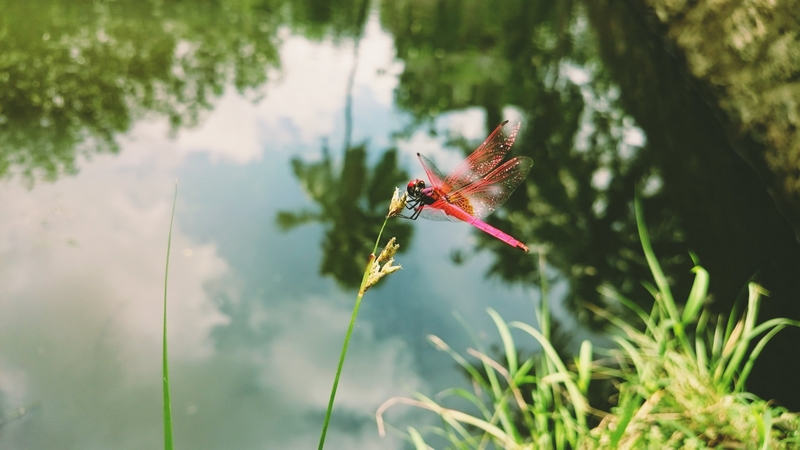
If you are close to overhanging trees, a skimmer may well be a necessity. The advantage is water clarity as fallen leaves provide nutrients for algae.
Water circulation
The water must be able to circulate freely to achieve two objectives.
Filtration:
If the water can’t circulate through the regeneration zone, your pool won’t stay clear for long.
Comfort:
Circulation will distribute the water temperature evenly. Without it, the water will be warm near the surface and progressively cooler as you go deeper.
The good news for you, your budget and the environment is that the required pump is small and requires minimal energy.
Construction method
There are three alternative systems or methods you can consider.
1/ Block wall construction
This system allows you to have a very precise shape with vertical walls in the swimming area. You can achieve the most efficient use of space with this method. The downside is that it is more expensive and requires a greater skill level.

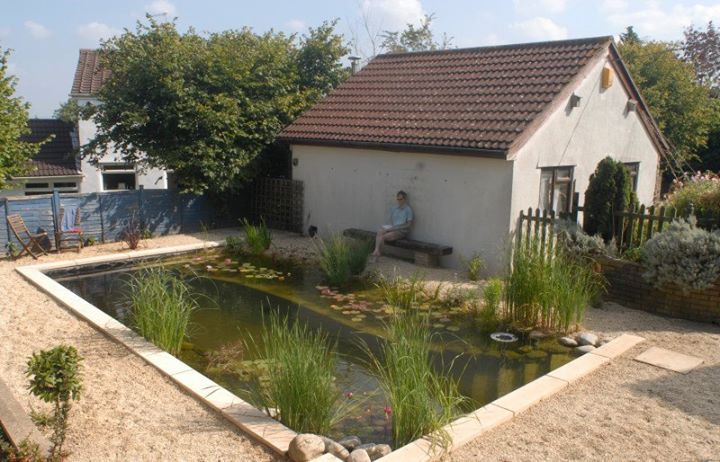
2/ Corner element construction
This system uses prefabricated and precast components as much as possible. Construction is quick and easy and it’s possible to have seating built in. This method allows very flexible design while keeping costs moderate.

3/ Earth wall construction
This is the cheapest and easiest system for owner-builders. It’s well within any person’s skill level and can be finished in a week! The downside is that it requires more space due to the gently sloping walls.

In our next NSP post, we’ll be focusing on this third alternative since, as stated, it is well within any person’s skill level.

Soil, Groundwater, and Liner Choices for a Natural Swimming Pond
Site conditions decide how your pond holds water and stays stable. Test soil, map groundwater behavior, and compare liners early. Smart choices protect banks, control seepage, and lower long-term maintenance.
Assessing Native Soil and Subgrade
Start with a soil test pit and a simple jar test to estimate clay content and permeability. Sandy or fractured soils leak. Highly plastic clays swell and crack. Remove organics, roots, and soft spots until you reach competent subgrade.
Shape shelves with gentle slopes. Compact in lifts with a plate compactor. A smooth, dense base reduces punctures, controls settlement, and supports consistent liner contact.
Groundwater Pressures and Drainage Strategy
Locate the seasonal high water table using local records and observation wells. Upward pressure can float flexible liners and buckle rigid shells. Add underdrains or a sump to relieve pressure during storms.
Where hillside seepage exists, intercept it with a gravel trench and perforated pipe daylighted downslope. Provide an overflow weir or pipe sized for heavy rain. Controlled exits prevent erosion, muddy water, and bank slumps.
Comparing Liner Materials
EPDM rubber is flexible, forgiving to install, and repairable with patches. Reinforced PVC can be cost effective but may age faster in sun. HDPE offers high puncture resistance and strong welded seams, yet needs skilled installers.
Natural clay or bentonite can seal cohesive soils when compacted correctly. Combine a nonwoven geotextile underlay with any liner to spread loads, cushion punctures, and improve longevity.
Liner Protection and Seaming Best Practices
Pad corners and shelves with extra geotextile. Remove stones before placement. Unroll liner in cool weather to reduce wrinkles. Anchor edges in a trench beyond the waterline and backfill firmly. Overlap according to the manufacturer.
Use primer and tape for EPDM, and extrusion welding for HDPE. Test seams before covering. Protect exposed edges from sunlight with coping stones, turf, or timber.
Pump Sizing, Flow Rates, and Quiet Circulation Layouts
Clear water relies on circulation through the regeneration zone and skimmer. Size pumps to match turnover goals and head losses. Plan paths that move debris quietly without creating harsh currents.
Calculate Turnover and Head Loss
Set a baseline of one to two full pond turnovers per day, then adjust for climate, plant density, and fish. Calculate dynamic head by adding static lift, pipe friction, and fittings. Manufacturer pump curves show flow at that head.
Oversizing wastes energy. Undersizing leaves dead zones. Target gentle intake velocities at skimmers and bottom drains. Balance flows so the regeneration zone sees consistent, oxygen-rich water.
Choosing the Right Pump Technology
External centrifugal pumps offer long life and high efficiency for larger ponds, but need priming and dry placement. Submersible pumps are compact and simple to install, yet can be less efficient.
Variable-speed models let you tune turnover by season and noise goals. Select corrosion-resistant housings and screened intakes. Keep a backup pump or quick-swap union ready to maintain circulation during maintenance or failures.
Pipe Sizing, Valves, and Energy Use
Use larger diameter piping to lower friction and head, then balance branches with gate or ball valves. Gentle sweeps beat sharp elbows. Flexible PVC simplifies routing. Place check valves to prevent backflow into the filter pit.
Minimize vertical lifts where possible. A low-head system paired with an efficient, variable-speed pump cuts electricity costs, extends pump life, and reduces sound levels near seating.
Layout Ideas for Quiet, Even Flow
Draw a clockwise or counterclockwise loop that drifts surface debris toward skimmers without creating a jet. Hide returns under stepping stones or at shelf edges to diffuse energy. Split flows between surface and bottom returns.
Add a planted boulder cascade for aeration without splash noise. Keep pumps on vibration pads inside a vented box so night sounds remain water, insects, and breeze.
Conclusion
What are your thoughts on natural pools/swimming ponds? What questions can we answer for you to help you decide if one is in your stars? Just post your comments and questions below. Don’t forget to share this article with your friends.
You might also enjoy reading Is a natural swimming pond the solution to swimming pool headaches?




